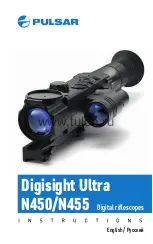
50
Daytime Observing
Your Celestron telescope works well as a terrestrial spotting scope. When not used to examine objects in the night sky, it
can be used to study objects here on Earth.
WARNING ! NEVER POINT YOUR TELESCOPE AT THE SUN UNLESS YOU HAVE THE PROPER SOLAR
FILTER. PERMANENT AND IRREVERSIBLE EYE DAMAGE MAY RESULT AS WELL AS DAMAGE TO
YOUR TELESCOPE. ALSO, NEVER LEAVE YOUR TELESCOPE UNATTENDED DURING A DAYTIME
OBSERVING SESSION, ESPECIALLY WHEN CHILDREN ARE PRESENT.
1.
Begin by finding a distant object that is fairly bright.
2.
Insert a low power eyepiece (one with a large focal length) into the telescope. The standard 26mm eyepiece is fine.
3.
Point the telescope in the general direction of the object you selected.
4.
Locate the object in your finderscope.
5.
Center the object in the field of the finderscope by using the hand control buttons or moving the tube manually very
slowly.
6.
Once centered, look through the main optics and the object will be there (if you aligned the finder first).
Try using different optional eyepieces to see how the field changes with various magnifications. Casual terrestrial
observing can be done with the telescope and fork mount placed on a flat, sturdy surface.
Calculating Magnification
You can change the power of your telescope just by changing the eyepiece (ocular). To determine the magnification for
the Ultima 2000 - 8", you would simply divide the focal length of the telescope (2032mm) by the focal length of the
eyepiece that you are using. In equation format, the formula looks like this:
Focal Length of Telescope (mm)
Magnification = ———————————————
Focal Length of Eyepiece (mm)
Let’s say, for example, that you are using a 10mm eyepiece. To determine the magnification, simply divide the focal
length of your 8” (2032mm) by the focal length of the eyepiece (lOmm). Dividing 2032 by 10 yields a magnification of
203 power.
Although the power is variable, each instrument has a limit to the highest useful magnification. The general rule is that 60
power can be used for every inch of aperture. For example, the Ultima 2000-8” is 8” in diameter. Multiplying 8 by 60
gives a maximum useful magnification of 480 power. Although this is the maximum useful magnification, most observing
is done in the range of 20 to 35 power for every inch of aperture which is 160 to 280 power for the 8”.
Determining Field of View
Determining the field of view is important if you want to get an idea of the size of the object you are observing. To
calculate the actual field of view, divide the apparent field of the eyepiece (supplied by the eyepiece manufacturer) by the
magnification. In equation format, the formula looks like this:
Apparent Field of Eyepiece (in degrees)
True Field = ———————————————
Magnification








































